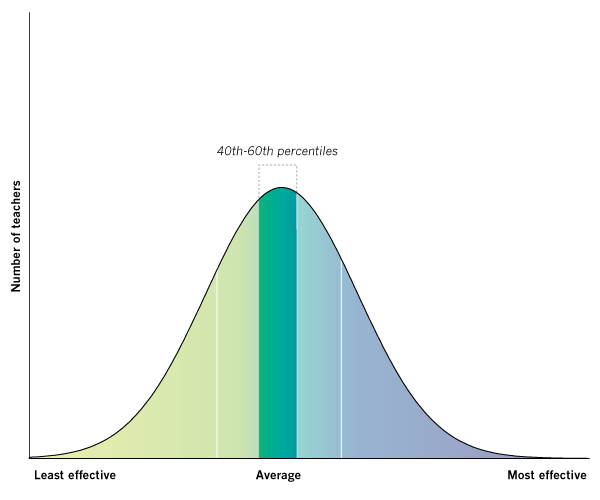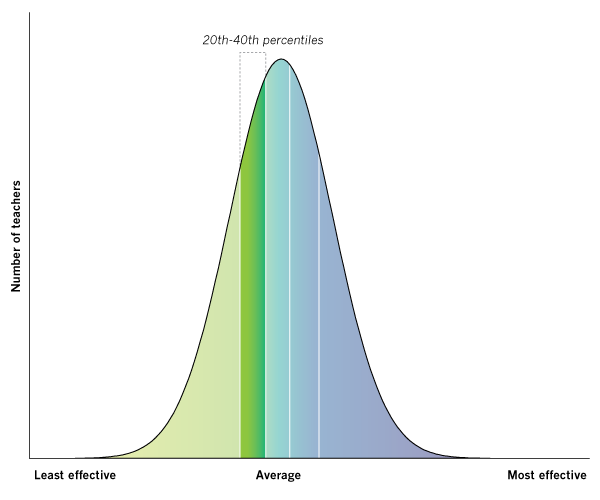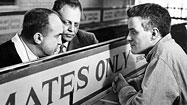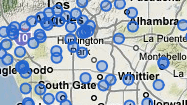Derin Kennedy Lowry
A 4th grade teacher at Forty-Ninth Street Elementary in 2009
These graphs show a teacher's "value-added" rating based on his or her students' progress on the California Standards Tests in math and English. The Times’ analysis used all valid student scores available for this teacher from the 2002-03 through 2008-09 academic years. The value-added scores reflect a teacher's effectiveness at raising standardized test scores and, as such, capture only one aspect of a teacher's work.
Compared with other Los Angeles Unified teachers on the value-added measure of test score improvement, Lowry ranked:
- Average overall.
- Average in math. Students of teachers in this category, on average, did not gain or lose significantly on the California Standards Test compared with other students at their grade level.
- Less effective than average in English. Students of teachers in this category, on average, lost about 3 percentile points on the California Standards Test compared with other students at their grade level.
Lowry's LAUSD teaching history
2002-03 through 2008-09 academic years
- Forty-Ninth Street Elementary, 2009 - 2003
Derin Lowry's Response:

For anyone reading the VAM rating put on me by the L.A. Times, please keep these things in mind:
1. I used to teach severely emotionally disturbed children (in a special education class) at this school, which is located in South-Central Los Angeles. I worked with some who had committed crimes as minors. As a result, since making the switch to teaching regular ed., I have regularly been given students who pose serious behavioral challenges, year after year. Men such as myself often receive the most unruly students as there is a prevailing notion that we can handle them. As a result, my classes have been chronically disrupted. I have had students who have brought weapons to school, committed sexual assault, and have otherwise been violent towards other students and sometimes towards me. Disruptive behavior has been a constant issue at this school, for which there has been no adequate remedy. Suspensions and occasional expulsions are only partially effective in dealing with these problems. When an inordinate amount of time is spent during each school day quelling conflicts among students, valuable instructional time is lost.
2. The CST data from the years in which I taught 2nd grade are irrelevant to this VAM rating. The grade level info for my name/data implies that this data was also taken into account, going back several years. However, since the VAM relies on comparing students' CST scores to their scores from previous years of testing, there is no comparison to be made for 2nd graders. Why is this? This is because first graders do not take the CST. Therefore, it is misleading to suggest that CST scores from the years in which I taught 2nd grade is somehow related to the "average" rating I received. It is not relevant. If my 2nd grade students scored very well on the CSTs, (as a result of my working very hard), then my rating as a teacher could not benefit from this at all.
3. The majority of the students I have taught at this school have been English Language Learners who have limited English proficiency. Many are recent immigrants or the children of recent immigrants (typically from Mexico or Central America). After being in the U.S. for only one year, these same students are subjected to being tested on the CST in English. It is therefore not suprising that many of them fail to perform well when they are still trying to learn the basics of the language. Blaming and scapegoating teachers for a lack of academic performance on the part of their students is a very narrow and misguided approach toward solving a complicated problem. One thing that WOULD help our students is parental literacy and involvement in the educational process at home.
4. The CST data that I have been shown at my school for the 4th and 3rd grade students I have taught indicate trends which are the OPPOSITE of what is being shown above. Put simply, my 4th (and 3rd) grade students have typically fared BETTER in Reading/Language Arts than they have on the Math portion of the CST. For example, 78% of my 4th grade students from 2009-2010 scored higher on the Reading/Language Arts portion of the CST in 4th grade as compared to their 3rd grade scores. 12% went down. In Math, 61% scored either higher or the same as in 3rd grade, while 39% scored worse. While this data was not included in the VAM for this database, it is consistent with the trends from previous years, which show that my students have typically improved more in Reading/Language Arts than they have in Math. Yet, I have been labeled as "Less effective than average in English" - which leads one to wonder the following: either that the "average" gains in Reading/Language Arts across the district must be very impressive among my peers, or that this methodology for rating teachers is unreliable.
5. I am also required to teach social studies, science, English Language Development (since most of my students are not native English speakers), art, music, health, and physical education. Teachers do not spend all of their time teaching reading and math. These other subjects are not assessed on the CST. Any benefits that I may have imparted to my students in these subjects is not taken into account with the VAM.
6. I have 34 students in my class, and a teaching assistant for 25-minutes per day. Those who teach 3rd grade (or lower grades) typically have about 20 students (give or take a few) and have teaching assistants for longer periods of time. It is more difficult to ensure the proficiency of each student when class sizes are larger, and assistance is reduced. I'm only one person. If we as a society want to solve the "achievement gap," then hire more people to work together to educate our children. I cannot give the individual attention that I would like to give to each student each day.
7. Some teachers with higher rankings of effectiveness (e.g. 'more effective' or 'most effective') are either: a) great teachers doing a wonderful job who are able to reach most of the students in their classes, or b) cheaters who help to supply the answers to their students during the CST in an effort to make themselves look effective.
![]() The Times gave LAUSD elementary school teachers rated in this database the opportunity to preview their value-added evaluations and publicly respond. Some issues raised by teachers may be addressed in the FAQ. Teachers who have not commented may do so by contacting The Times.
The Times gave LAUSD elementary school teachers rated in this database the opportunity to preview their value-added evaluations and publicly respond. Some issues raised by teachers may be addressed in the FAQ. Teachers who have not commented may do so by contacting The Times.
|
|
 Delicious
Delicious
|
 Digg
Digg
|
 Facebook
Facebook
|
 Twitter
Twitter
|









